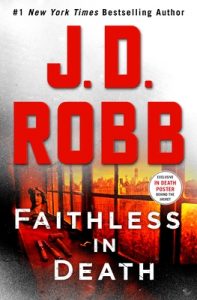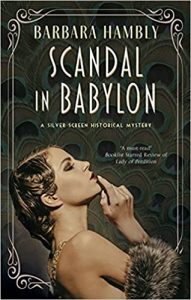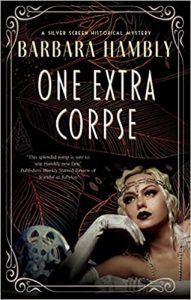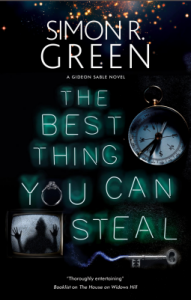 Crypt of the Moon Spider (Lunar Gothic Trilogy, #1) by Nathan Ballingrud
Crypt of the Moon Spider (Lunar Gothic Trilogy, #1) by Nathan Ballingrud Format: eARC
Source: supplied by publisher via NetGalley
Formats available: hardcover, paperback, ebook
Genres: Gothic, horror, science fiction
Series: Lunar Gothic Trilogy #1
Pages: 112
Published by Tor Nightfire on August 27, 2024
Purchasing Info: Author's Website, Publisher's Website, Amazon, Barnes & Noble, Kobo, Bookshop.org, Better World Books
Goodreads
Crypt of the Moon Spider is a dark and dreamy tale of horror, corruption, and identity spun into the stickiest of webs.
Years ago, in a cave beneath the dense forests and streams on the surface of the moon, a gargantuan spider once lived. Its silk granted its first worshippers immense faculties of power and awe.
It’s now 1923 and Veronica Brinkley is touching down on the moon for her intake at the Barrowfield Home for Treatment of the Melancholy. A renowned facility, Dr. Barrington Cull’s invasive and highly successful treatments have been lauded by many. And they’re so simple! All it takes is a little spider silk in the amygdala, maybe a strand or two in the prefrontal cortex, and perhaps an inch in the hippocampus for near evisceration of those troublesome thoughts and ideas.
But trouble lurks in many a mind at this facility and although the spider’s been dead for years, its denizens are not. Someone or something is up to no good, and Veronica just might be the cause.
My Review:
When we first meet Veronica Brinkley as she’s on her way to the Barrowfield Home for Treatment of the Melancholy, we already know that this is not going to be a pretty story because the sense of creeping dread is there from the very first page.
At first, in spite of the story’s setting, that creeping dread is of the mundane but still extremely chilling variety. It’s clear that it’s set at in a period where it was entirely too easy for a woman to be labeled “mad” or “melancholy” or “hysterical” by doctors in cooperation with their husbands and fathers as a way of getting rid of an inconvenient child or spouse by locking them up in an asylum and waiting to receive word of their inevitable demise.
Veronica is well aware that her husband doesn’t expect her “black spells” to ever be cured. She’s never expected to return to their Boston home. The most terrible part of the opening of the story is that she feels she’s earned her place at Barrowfield – that it’s what she deserves for being weak, useless and self-absorbed. For failing in her duties as a wife.
And her treatment is horrific enough – and would be even if it was confined to the historically available treatments of its 1920s setting. But this is a version of our world – and our solar system – that owes a lot to the science fiction of H.G. Wells and Jules Verne.
Barrowfield is on the moon, a moon that once housed an indigenous species of giant spiders that would have the power to make even the mighty Shelob quake in her lair.
But those giant spiders left behind vast webs in the lunar forests, and a surprising number of more-or-less human priests and worshippers who seem to be passing the gifts of the moon spiders on to the staff at Barrowfield, where the patients are treated by scooping out parts of their brains and replacing their supposedly diseased brain matter with moon spider silk.
It sounds barbaric – only because it is. It’s clear that Barrowfield’s medical chief has an agenda for his experimentation that he never reveals to the wealthy clients who commit their wives and daughters to his care. He knows they don’t, wouldn’t and won’t care about any supposed ‘treatment’ he might possibly think to administer.
But the acolytes of the moon spiders have an agenda of their own. And in Veronica Brinkley, they’ve found the perfect receptacle for their hopes, dreams and plans. All they have to do is wait, and watch, and let the doctor do his work – up to the point where they can finally do their own.
Escape Rating B: I was absolutely fascinated and utterly creeped out by this story, all at the same time. If it had stayed with historical treatments it would have been creepy enough, because damn but they were.
Howsomever, the elements of Verne and Wells and the moon spiders absolutely kicked the whole thing onto another level entirely. Not in the way that the acolytes took control of Barrowfield, because that was both expected and honestly hoped for in a peculiar way.
But the implications that the reader is left with at the end definitely embody next-level chill.
Which is where the issue I had with this book absolutely kicked in with a vengeance. Not that the vengeance aspects of the story bothered me at all because all the men involved with this story were a despicable and deserving bunch of fellows.
 The SFnal aspects of the story were enough to carry me over – or perhaps through – the horror aspects of the thing, except for the image of Veronica left in my mind at the end. For anyone who has ever played Dragon Age: Awakening, the expansion for Dragon Age: Origins, well, in my head Veronica ends up as a saner, more self-aware version of The Mother from that game, and the idea of a saner version is seriously both frightening and stomach-churning. (The picture at left is actually one of the less horrific images.)
The SFnal aspects of the story were enough to carry me over – or perhaps through – the horror aspects of the thing, except for the image of Veronica left in my mind at the end. For anyone who has ever played Dragon Age: Awakening, the expansion for Dragon Age: Origins, well, in my head Veronica ends up as a saner, more self-aware version of The Mother from that game, and the idea of a saner version is seriously both frightening and stomach-churning. (The picture at left is actually one of the less horrific images.)
Circling back around, the thing that is keeping this from an A-, because I was certainly riveted, chilled and downright appalled at points more than enough for that, is that the story feels incomplete – and not just in the sense that it’s labeled as book 1 in a trilogy.
I’m left on the horns of a reading dilemma that it feels like I didn’t get enough of this story – even though it contains plenty of things that I wouldn’t want in any more detail. It’s more that I turned the final page feeling like I didn’t know nearly enough of how this world got to this point and that I was piecing together bits in my mind much the same way that Veronica’s mind got pieced together and I feel the missing bits every bit as much.
Which means I’ll be waiting with the proverbial bated breath for book 2, Cathedral of the Drowned, in the creeped out hope that I’ll get more of that connective spider silk in the next part of the story this time next year!

 Passions in Death (In Death, #59) by
Passions in Death (In Death, #59) by  The villain in Passions in Death was almost as much of a ‘dooser’ as the villain in the previous book,
The villain in Passions in Death was almost as much of a ‘dooser’ as the villain in the previous book,  All of which means that Dallas will have to dig, and dig hard, into every single one of those supposedly happy partygoers to discover who in Erin and her fiancée Shauna’s tight-knit little tribe wasn’t nearly so happy as they pretended to be.
All of which means that Dallas will have to dig, and dig hard, into every single one of those supposedly happy partygoers to discover who in Erin and her fiancée Shauna’s tight-knit little tribe wasn’t nearly so happy as they pretended to be. A lot has changed for both of them, and for the found family they have gathered around them, in those three years, more than enough for them to get a bit nostalgic at revisiting earlier scenes, but not nearly as much change as the world outside the series has experienced in three DECADES.
A lot has changed for both of them, and for the found family they have gathered around them, in those three years, more than enough for them to get a bit nostalgic at revisiting earlier scenes, but not nearly as much change as the world outside the series has experienced in three DECADES. Come to think of it, their dooserness wasn’t the only thing the two villains had in common. Which doesn’t help the case for the story or the doosers.
Come to think of it, their dooserness wasn’t the only thing the two villains had in common. Which doesn’t help the case for the story or the doosers. Saving Susy Sweetchild (Silver Screen Historical Mystery #3) by
Saving Susy Sweetchild (Silver Screen Historical Mystery #3) by  Because she sees entirely too much, and is all too aware that she can’t fix ANY of it. Although she certainly does what she can, as shown in the first two books in the
Because she sees entirely too much, and is all too aware that she can’t fix ANY of it. Although she certainly does what she can, as shown in the first two books in the  Escape Rating B: There are two stories going on in Saving Susy Sweetchild, and I have to admit that one interested me considerably more than the other.
Escape Rating B: There are two stories going on in Saving Susy Sweetchild, and I have to admit that one interested me considerably more than the other. The Ghost Cat by
The Ghost Cat by  Pivoting from my digression, I also have to say that I’m glad I read this AFTER the trip to Glasgow and not before – even though this is set in Edinburgh. There are a few things – like the ubiquitous presence of
Pivoting from my digression, I also have to say that I’m glad I read this AFTER the trip to Glasgow and not before – even though this is set in Edinburgh. There are a few things – like the ubiquitous presence of 
 The Full Moon Coffee Shop (The Full Moon Coffee Shop, #1) by
The Full Moon Coffee Shop (The Full Moon Coffee Shop, #1) by  Escape Rating B: At first, the stories seem a bit random, as they often do in this kind of book. I’m thinking of
Escape Rating B: At first, the stories seem a bit random, as they often do in this kind of book. I’m thinking of  Memories of the Lost by
Memories of the Lost by  Escape Rating B+: I picked this up because I’ve enjoyed several of the author’s previous works, particularly
Escape Rating B+: I picked this up because I’ve enjoyed several of the author’s previous works, particularly 
 The Hermit Next Door by
The Hermit Next Door by  Escape Rating B: I finished this book with a lot more mixed feelings than I expected. I thought I would just love it (spoiler: I did love
Escape Rating B: I finished this book with a lot more mixed feelings than I expected. I thought I would just love it (spoiler: I did love  She Who Knows by
She Who Knows by  Escape Rating B+: She Who Knows is the first book in a prequel trilogy of novellas to the author’s award-winning novel
Escape Rating B+: She Who Knows is the first book in a prequel trilogy of novellas to the author’s award-winning novel  Where is Anybody? (Gideon Sable, #5) by
Where is Anybody? (Gideon Sable, #5) by  But he’s been trying to go straight – or as straight as anyone can who operates in Old Soho – after the events of
But he’s been trying to go straight – or as straight as anyone can who operates in Old Soho – after the events of  But he’s not really Gideon Sable. Or rather he IS Sable now but he hasn’t always been. In Old Soho, the mask and moniker of Gideon Sable belongs to whoever can steal it and keep it. In the first book in the series,
But he’s not really Gideon Sable. Or rather he IS Sable now but he hasn’t always been. In Old Soho, the mask and moniker of Gideon Sable belongs to whoever can steal it and keep it. In the first book in the series,  Lady Macbeth by
Lady Macbeth by 
 (If you’re wondering – as I was – it reminds me of
(If you’re wondering – as I was – it reminds me of